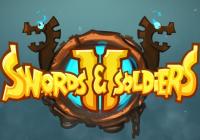Swords & Soldiers II (Wii U) Review
By Aria DiMezzo  20.05.2015
20.05.2015

Although Swords & Soldiers II is a sequel, no knowledge of the preceding game from both WiiWare and Wii U eShop is necessary to dive in, learn the system, and enjoy what is on offer. Ronimo Games calls it a "side-scrolling strategy" title, and it is not wrong. With depth typical of an RTS compressed into two dimensions, with a bit of a "temple runner" mixed in, it's pretty clear why Swords & Soldiers II took two and a half years to merge complexity so seamlessly with simplicity. Cubed3 has the final say on how it has turned out.
Swords & Soldiers II takes the complexity of the Real-Time Strategy genre and compresses it into a 2D battlefield that is easy to learn, but difficult to master. Ronimo Games has crafted an experience that is graphically appealing but not hard on the eyes, that is accessible but not oversimplified, and that is challenging but not unfairly difficult.
It's difficult to imagine the intricacies of a standard RTS in only two-dimensions, and sacrifices to complexity were necessary to make this happen. Fans of the RTS genre will likely cringe at these concessions, but the overall experience doesn't suffer. People who enjoy the genre in passing will find a lot to love about Swords & Soldiers II. This isn't to say that it's not for hardcore fans; it certainly delivers enough to please that sector, but it may be difficult to let go of things like troop movement and location choices for buildings.
Characters move automatically, and there is no way to stop them from doing so. While this means that it isn't necessary to extensively micromanage movement, it also means that weakened soldiers will walk straight into the enemy and be slaughtered. Varying soldier speeds and alternate paths require a small bit of micromanagement, but the maps are designed around this, and the result is that it's usually the player's fault when a soldier traipses merrily to its doom.

In addition to putting together an army, buildings can be constructed at specific points on the map. These range in purpose, and it's important to carefully determine and construct the building that will be most helpful. Whether a mana tower or defence tower would be the best use of resources depends on the map, the circumstances, and, above all, the player's style.
There is a lengthy campaign involving the theft of a magic lamp and some atrocious voice acting, but Swords & Soldiers II doesn't take itself too seriously. It delivers silly dialogue with intentionally bad accents (or so it is to be hoped), and, although the voice acting honestly can cause shuddering cringes, the story itself is decent and the dialogue is reasonably amusing, most of the time.
Random overworld battles provide respite from the story, and in these skirmishes gamers can choose from among the abilities, units, and buildings unlocked through the campaign to construct a customised army. With everything unlocked and all choices available, these Skirmish battles are where everything really shines. The local multiplayer is definitely fun, although the lack of online play could severely hinder the experience if friends and family aren't RTS fans.

Cubed3 Rating
Very Good - Bronze Award

Amusing dialogue, lush and vibrant graphics, a lengthy campaign, accessibility, depth, and local multiplayer allow Swords & Soldiers II to provide entertainment to a wide audience. Ronimo Games' title strikes a nice balance between depth and complexity. Although there is a quality campaign to be enjoyed, it is little more than a way to unlock all the factions, units, abilities, and spells to be used in the skirmish modes, because the skirmishing is where Swords & Soldiers II really shines.
Comments
Comments are currently disabled

 Sign In
Sign In Game Details
Game Details
 Out now
Out now  Out now
Out now  None
None  Out now
Out now  Subscribe to this topic
Subscribe to this topic Features
Features






 Top
Top

